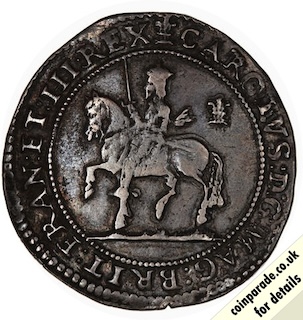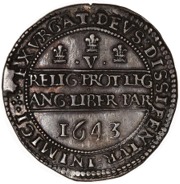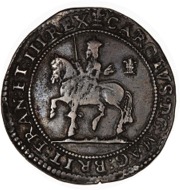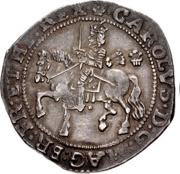
 The 1643 Crown - Charles I
The 1643 Crown - Charles ISilver Crown, Oxford Mint. Diameter 44mm, weight 28.816g.
There are large number of variations of Charles I crowns. This one is stated as Spink 2946A.
The Reverse shows the 3 plumes of the Oxford Mint. The Roman numeral 'V' under the middle plume is the denomination (5 shillings). The inscription is declaring The religion of the Protestants, the laws of England, the liberty of Parliament.
 The Obverse shows Charles on horseback carrying a sword.
The Obverse shows Charles on horseback carrying a sword.Images credit: Justine Philip, Museums Victoria.
Mintage: Not known
Minted at The Royal Mint
SCBC: 2946A
More information (monarch, year, mint, country, category) can be found below coin listings.
Below are some coins currently being offered on eBay. As an eBay Partner, We may be compensated if you make a purchase.
List items on:
List items on:
Remember 1643 ?
Monarch is King Charles I. Almost the entire year is dominated by the battles of the English Civil War.
Charles I (1625-1649)
 Charles I was born on 19 November 1600 and was King of England, King of Scotland, and King of Ireland from 27 March 1625 until his execution on 30 January 1649. He was in the House of Stuart.
Charles I was born on 19 November 1600 and was King of England, King of Scotland, and King of Ireland from 27 March 1625 until his execution on 30 January 1649. He was in the House of Stuart.From 1642, Charles fought in the English Civil War against the armies of the English and Scottish parliaments. After his defeat in 1645, Charles refused to accept his captors' demands for a constitutional monarchy. He escaped for a few years but was recaptured by Oliver Cromwell's New Model Army. He was tried for high treason and subsequently executed.
The monarchy was abolished and the Commonwealth of England became a republic. The monarchy would be restored in 1660 by Charles's son, Charles II.
The coinage of Charles I is one of the most interesting periods of English numismatic history. There are a huge amount of varieties and the coins include both hammered and early machine-made coins by Briot. Due to the Civil war many mints popped up around the country. It's a complex and involved subject featuring some outstanding coins. It probably takes an expert to identify a coin correctly.
Category: Crowns
The Crown is a very old coin, with origins dating back to Henry VIII. The English Crown first appeared in 1526. It was made of 22 carat gold ("crown gold") and has a value of five shillings (a quarter of a pound).By 1551, silver was being used to produce crowns, although gold was sometimes still used. The silver crown was quite large, being about 38mm and weighing about one ounce. Around that time many Europeans countries had similar sized silver coins which made them good for international trade as they were essentially interchangeable.
The metal used was 92.5% silver and the rest copper so as to make the coin harder. This hardness, together with a milled edge, made 'clipping' (which was cutting slices off the edge to steal some free silver) more difficult.
After the Union of England and Scotland in 1707 a new coin, the British Crown, replaced the English Crown and Scottish Dollar. The value was set at 5 shillings and the size was 38mm in diameter and weighed about 1oz as before.
Now more of a commemorative coin
Although the coin was always part of the British coin family, its large size made it unpopular for general circulation and the half-crown was favoured as the de-facto largest coin in circulation. The Crown was more-or-less relegated to a commemorative coin.
The British economy, especially after the World Wars, took its toll on the crown too. From 1816-1919 the crown was 0.925 silver, this was reduced to 0.500 silver in 1920 and in 1947 the Crown became Cupronickel (75% copper, 25% nickel). The size standardised at 38.61 mm and (silver crown) weight of 28.276g (1 oz).
Although not in current circulation, the Crown is still legal tender. After decimalisation in 1971 the Crown was officially valued at 25 pence. In the Eighties we had inflation which brought in higher denomination coins like the pound coin and the two-pound coin, so the Government decided that the crown needed to be restored to it former glory as biggest denomination coin and the crown was re-denominated to £5 in 1990.
Today the Crown is once again made in silver and gold, usually to satisfy collectors and investors. There is a little confusion with this as there are Gold Crowns which are worth £5 but there is another five-pound Gold coin from the sovereign family - see the article on Gold £5 Coin or Gold Crown?
Which Mint: The Royal Mint
The Royal Mint is the designated place for the UK to mint coins. It dates back well over 1000 years and is a Government-owned company. Formed in the reign of Alfred the Great about the year 886, during the period 1279-1812 it was generally referred to as The Tower Mint as it was housed at the Tower of London. The Master of The Royal Mint has included famous figures such as Sir Isaac Newton.
Since 2010 it has operated as Royal Mint Ltd, a company owned by HM Treasury, under an exclusive contract to supply all coinage for the UK although it also produces medals and coins for other countries. It is currently located at Llantrisant, Wales.
Country of Origin: United Kingdom
The United Kingdom (UK) is the Union of England, Scotland, Wales and Northern Ireland. It is often refered to as Great Britain (GBR). It has a long, rich history. The orignal coinage was Pounds, Shillings and Pence but since decimalisation on 15 February 1971, it is £1 = 100p, that is One Pound = 100 pence. The coinage of the UK is also a long history, the Royal Mint being established as long ago as 886AD when coins were hammered. Today there is perhaps 30 billion coins in circulation, and many (numismatic) collectors coins and sets are issued frequently in gold, silver and other metals.








